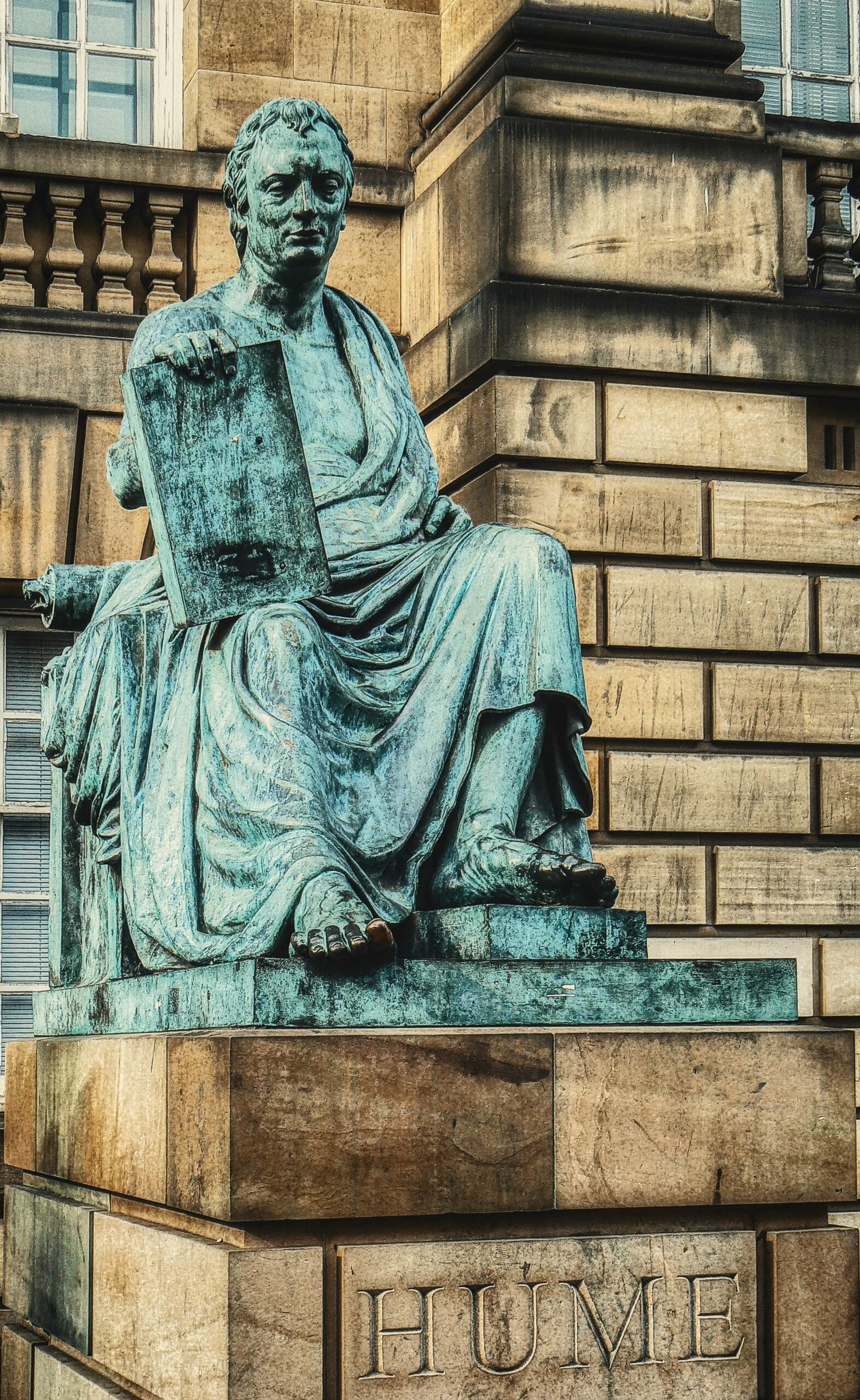Descartes’ philosophy is characterized by his methodical approach to knowledge and his exploration of the mind-body relationship. In his famous work, “Meditations on First Philosophy,” Descartes sets out to establish a foundation for knowledge that is beyond doubt. He employs a method of doubt, systematically questioning everything he believes to be true in order to arrive at indubitable truths.
Descartes famously states, “I think, therefore I am,” as a starting point for his philosophy. By recognizing that the act of doubting implies the existence of a doubter, Descartes establishes the certainty of his own existence.
From this foundational truth, Descartes proceeds to establish the existence of God and the external world. He argues that the idea of a perfect and infinite being, which he finds within himself, cannot be the product of his own finite and imperfect mind. Descartes therefore comes to the conclusion that a higher power, specifically God, must have implanted this idea in his mind. Descartes’ argument for the existence of God is known as the ontological argument and has been a subject of much debate among philosophers.
Descartes also explores the relationship between the mind and the body, known as the mind-body problem. He posits that the mind and the body are distinct substances, with the mind being a thinking substance and the body being an extended substance. This dualism is in contrast to the prevailing view at the time, which saw the mind and body as interconnected and inseparable. Descartes argues that the mind and body interact through the pineal gland, a small structure in the brain that he believed to be the seat of the soul.
Descartes’ philosophy had a profound impact on subsequent thinkers and continues to be influential today. His emphasis on reason and systematic doubt laid the groundwork for the Enlightenment period and the scientific revolution. Descartes’ method of inquiry, known as Cartesian doubt, continues to be used in various fields of study, including philosophy, science, and mathematics. His ideas on the mind-body problem have also sparked ongoing debates and investigations into the nature of consciousness and the relationship between the physical and the mental.
In conclusion, René Descartes was a pioneering philosopher and mathematician who played a crucial role in the development of rationalism. His methodical approach to knowledge and his exploration of the mind-body relationship have left a lasting impact on philosophy and other disciplines. Descartes’ philosophy continues to be studied and debated, making him a significant figure in the history of ideas.
Descartes believed that the first step in the Cartesian Method was to doubt everything that could be doubted. This included not only sensory perceptions and mathematical truths, but also beliefs that were deeply ingrained in society and culture. He argued that by doubting all these beliefs, one could strip away the layers of uncertainty and arrive at truths that were indubitable.
Once all beliefs had been subjected to doubt, Descartes sought to find a foundation of knowledge upon which he could build. He believed that such a foundation could be found in the act of thinking itself. Descartes argued that even if everything else could be doubted, the fact that he was doubting and thinking was evidence of his existence. This led to his famous statement, “Cogito, ergo sum,” or “I think, therefore I am.”
With the foundation of his own existence established, Descartes then turned his attention to proving the existence of God. He believed that the concept of God was innate within human beings and that the existence of God could be proven through reason alone. Descartes’ argument for the existence of God relied on the idea that a perfect being must exist, and since he himself was an imperfect being, there must be a perfect being who had created him.
Having established the existence of God, Descartes then sought to prove the existence of the external world. He argued that if God exists and is not a deceiver, then our sensory perceptions must be reliable to some extent. Descartes believed that God would not deceive us in such a way that we could not trust our senses, as this would go against his nature as a perfect being. Therefore, Descartes concluded that the external world must exist.
Finally, Descartes turned his attention to the relationship between the mind and the body. He believed that the mind and the body were two distinct entities, with the mind being immaterial and the body being material. Descartes argued that the mind and the body interacted through the pineal gland, a small structure located in the brain. He thought that the soul’s deeds—which he saw as the link between the mind and the body—facilitated this interaction.
In conclusion, Descartes’ Cartesian Method was a systematic approach to acquiring knowledge. By doubting all beliefs and accepting only those truths that could be proven beyond any doubt, Descartes aimed to establish a foundation of certain knowledge. Through this method, he sought to prove the existence of God, the external world, and the relationship between the mind and the body. While Descartes’ ideas have been subject to much debate and criticism, his methodological approach to knowledge acquisition continues to influence philosophical and scientific inquiry to this day.
Descartes’ theory of mind-body dualism has sparked intense debate and discussion in the fields of philosophy and psychology. While some philosophers and scientists have embraced his ideas, others have criticized and challenged them.
One of the key questions raised by Descartes’ theory is the nature of consciousness. If the mind and body are truly separate entities, how does consciousness arise? Descartes himself believed that consciousness was a property of the mind and that it was distinct from the physical processes of the body. However, this raises further questions about how the mind and body interact to produce conscious experience.
Another area of inquiry that Descartes’ theory has influenced is the relationship between the mind and the body. If the mind and body are separate substances, how do they interact? Descartes proposed that this interaction occurred in the pineal gland, but this idea has been met with skepticism. Some philosophers and scientists argue that there must be a more complex and nuanced explanation for how the mind and body interact.
Furthermore, Descartes’ theory of mind-body dualism has implications for the concept of an afterlife. If the mind is immaterial and separate from the body, could it continue to exist after the body dies? This question has been a subject of much speculation and debate, with some arguing for the possibility of an afterlife and others dismissing it as mere wishful thinking.
Overall, Descartes’ theory of mind-body dualism has had a profound impact on our understanding of consciousness, the mind-body relationship, and the nature of existence. While his ideas have been both praised and criticized, they continue to provoke thought and inquiry into the mysteries of the human mind and its connection to the physical world.
Spinoza: God and Substance
Baruch Spinoza was a Dutch philosopher of the 17th century who developed a comprehensive philosophical system. Spinoza’s philosophy is characterized by his monist view of reality, his pantheistic conception of God, and his exploration of the nature of substance.
Spinoza’s monist view of reality posits that there is only one substance in the universe, which he calls God or Nature. According to Spinoza, this substance is infinite, eternal, and self-caused. It encompasses everything that exists and is the ultimate source of all reality. This monistic perspective challenges the traditional dualistic view that separates the physical and spiritual realms, suggesting instead that they are two aspects of the same underlying substance.
In Spinoza’s pantheistic conception of God, he equates God with the universe itself. For him, God is not a separate, personal being but rather the totality of all existence. This pantheistic understanding of God is rooted in Spinoza’s belief that everything that exists is a manifestation of God’s attributes. In other words, God is not transcendent but immanent, present in every aspect of reality.
Spinoza’s exploration of the nature of substance delves into the fundamental qualities and attributes of the one substance that underlies all things. He argues that substance is indivisible and cannot be broken down into smaller parts. It is self-sufficient and does not depend on anything else for its existence.
Substance, according to Spinoza, is characterized by infinite attributes, each of which expresses an aspect of its essence. However, humans can only comprehend two of these attributes: extension (physicality) and thought (mind).
Moreover, Spinoza proposes that everything that exists is a mode or modification of this one substance. Modes are finite expressions of substance that arise from its attributes. They are not independent entities but rather dependent on substance for their existence. This understanding challenges the notion of individuality and emphasizes the interconnectedness of all things.
Spinoza’s philosophy has had a profound impact on various fields, including metaphysics, ethics, and political theory. His monist view of reality and pantheistic conception of God have influenced thinkers such as Albert Einstein and Friedrich Nietzsche. Spinoza’s exploration of substance has also contributed to the development of modern metaphysics and the understanding of the nature of existence.
In conclusion, Baruch Spinoza’s philosophy is characterized by his monist view of reality, his pantheistic conception of God, and his exploration of the nature of substance. His ideas challenge traditional dualistic perspectives and emphasize the interconnectedness of all things. Spinoza’s philosophy continues to inspire and provoke thought, inviting us to reconsider our understanding of the universe and our place within it. Spinoza’s theory of substance, attributes, and modes is a complex and intricate philosophical framework that challenges traditional dualistic views and offers a unique perspective on the nature of reality. According to Spinoza, there is only one substance in the universe, which he refers to as “God” or “Nature.” This substance is not only infinite but also necessary and self-caused, existing independently of anything else.
In contrast to Descartes’ dualistic view, which posits a separation between mind and body, Spinoza argues that everything that exists is a modification or mode of this one substance. This means that everything in the world, including human beings, is an expression or manifestation of this underlying substance.
To further elaborate on his theory, Spinoza suggests that this substance possesses an infinite number of attributes. However, humans are only capable of perceiving two of these attributes: thought and extension. Thought refers to the mental realm, encompassing ideas, emotions, and consciousness, while extension pertains to the physical realm, including all material objects and their properties. These attributes are not separate from the substance itself, but rather different ways in which the substance expresses itself.
Moreover, Spinoza argues that everything that exists is a mode or modification of these attributes. Modes are finite and particular expressions of the attributes, representing specific instances or manifestations of thought and extension. For instance, a particular human being is a mode of the attribute of thought and extension, reflecting the unique combination of mental and physical characteristics that define an individual.
By exploring the implications of Spinoza’s theory of substance, attributes, and modes, we gain a deeper understanding of the nature of reality, the relationship between God and the world, and the essence of human existence. This theory challenges the notion of a dualistic separation between mind and body, emphasizing the interconnectedness and inseparability of thought and extension. It invites us to question our understanding of ourselves and the world, encouraging a more holistic and integrated perspective on the nature of being.
The theory of monads is a central concept in Leibniz’s philosophy, providing a framework for understanding the nature of reality and the existence of individual substances. According to Leibniz, the monads are the fundamental building blocks of the universe, each representing a unique and indivisible entity.
Monads, in Leibniz’s view, are not material particles but rather spiritual or metaphysical entities. They are self-contained and self-sufficient, possessing their own internal states and perceptions. Each monad is distinct from all others and expresses its own unique qualities and characteristics.
Leibniz believed that monads are the ultimate constituents of reality, and everything else, including physical objects and human beings, is composed of or derived from monads. He argued that monads develop internally on their own accord in accordance with their inherent nature rather than being subject to outside influences.
Furthermore, Leibniz posited that monads are windowless entities, meaning that they do not interact directly with one another. Instead, they are connected through a pre-established harmony, a divine plan that ensures the coherence and order of the universe. This pre-established harmony allows for the apparent interaction and coordination of monads without compromising their individuality.
Leibniz’s theory of monads has profound implications for various areas of philosophy, including metaphysics, epistemology, and ethics. It provides a framework for understanding the nature of reality as composed of individual, self-contained entities. It also raises questions about the nature of perception, consciousness, and the relationship between mind and body.
In addition to its philosophical significance, the theory of monads has influenced other disciplines, such as mathematics and physics. Leibniz’s concept of monads bears resemblance to the notion of point particles in mathematics and the idea of elementary particles in modern physics. It has also inspired thinkers in various fields, including Immanuel Kant and Arthur Schopenhauer.
In conclusion, Leibniz’s theory of monads offers a unique perspective on the nature of reality and the existence of individual substances. It provides a framework for understanding the interconnectedness and individuality of entities in the universe. Despite its complexity and metaphysical nature, the theory of monads continues to be a subject of interest and debate in philosophy and other disciplines.
Leibniz’s Theory of Monads and Pre-Established Harmony
Leibniz’s theory of monads and pre-established harmony presents a fascinating perspective on the nature of reality and the relationship between individual entities and the larger universe. According to Leibniz, monads are not simply physical particles or material substances, but rather metaphysical entities that possess consciousness and perception.
These monads are indivisible and self-contained, meaning that they cannot be divided or broken down into smaller parts. Each monad is a unique and independent entity with its own internal principles and nature. It perceives the world around it and acts according to its own internal motivations and desires.
What sets Leibniz’s theory apart from other philosophical frameworks is his idea that monads are not directly affected by external causes. Instead, they reflect the entire universe within themselves. Each monad is a miniature representation of the universe, and its internal nature alone governs its perceptions and actions.
Leibniz’s concept of pre-established harmony further adds to the complexity of his theory. He contends that, despite their independence, God synchronizes and harmonizes all monads with one another. In other words, they act in perfect coordination, as if they were pre-programmed to align with each other.
This notion of pre-established harmony allows for the existence of individuality and free will within a harmonious and interconnected universe. While each monad is distinct and autonomous, they are all part of a greater whole and work together in perfect harmony. It is as if the universe itself is a grand symphony, with each monad playing its unique part while still contributing to the overall harmony of the composition.
Leibniz’s theory of monads and pre-established harmony has profound implications for our understanding of the nature of reality and the relationship between individuals and the larger universe. It challenges the traditional view of causality and determinism, suggesting that there is a higher order at play where individual entities are both independent and interconnected.
This theory opens up new possibilities for exploring the nature of consciousness, free will, and the interconnectedness of all things. It invites us to question our assumptions about the boundaries of the self and the nature of reality itself. Leibniz’s theory of monads and pre-established harmony continues to inspire philosophical and metaphysical inquiries into the nature of existence and our place within it.
















+ There are no comments
Add yours